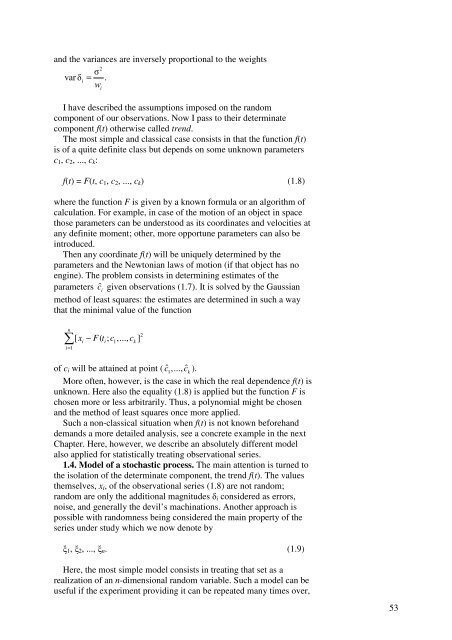1 Studies in the History of Statistics and Probability ... - Sheynin, Oscar
1 Studies in the History of Statistics and Probability ... - Sheynin, Oscar
1 Studies in the History of Statistics and Probability ... - Sheynin, Oscar
Create successful ePaper yourself
Turn your PDF publications into a flip-book with our unique Google optimized e-Paper software.
<strong>and</strong> <strong>the</strong> variances are <strong>in</strong>versely proportional to <strong>the</strong> weights2σvar δ = .iw iI have described <strong>the</strong> assumptions imposed on <strong>the</strong> r<strong>and</strong>omcomponent <strong>of</strong> our observations. Now I pass to <strong>the</strong>ir determ<strong>in</strong>atecomponent f(t) o<strong>the</strong>rwise called trend.The most simple <strong>and</strong> classical case consists <strong>in</strong> that <strong>the</strong> function f(t)is <strong>of</strong> a quite def<strong>in</strong>ite class but depends on some unknown parametersc 1 , c 2 , ..., c k :f(t) = F(t, c 1 , c 2 , ..., c k ) (1.8)where <strong>the</strong> function F is given by a known formula or an algorithm <strong>of</strong>calculation. For example, <strong>in</strong> case <strong>of</strong> <strong>the</strong> motion <strong>of</strong> an object <strong>in</strong> spacethose parameters can be understood as its coord<strong>in</strong>ates <strong>and</strong> velocities atany def<strong>in</strong>ite moment; o<strong>the</strong>r, more opportune parameters can also be<strong>in</strong>troduced.Then any coord<strong>in</strong>ate f(t) will be uniquely determ<strong>in</strong>ed by <strong>the</strong>parameters <strong>and</strong> <strong>the</strong> Newtonian laws <strong>of</strong> motion (if that object has noeng<strong>in</strong>e). The problem consists <strong>in</strong> determ<strong>in</strong><strong>in</strong>g estimates <strong>of</strong> <strong>the</strong>parameters c ˆigiven observations (1.7). It is solved by <strong>the</strong> Gaussianmethod <strong>of</strong> least squares: <strong>the</strong> estimates are determ<strong>in</strong>ed <strong>in</strong> such a waythat <strong>the</strong> m<strong>in</strong>imal value <strong>of</strong> <strong>the</strong> functionn∑i=1[ x − F( t ; c ,..., c ]i i 1 k2<strong>of</strong> c i will be atta<strong>in</strong>ed at po<strong>in</strong>t ( cˆ1,..., c ˆk).More <strong>of</strong>ten, however, is <strong>the</strong> case <strong>in</strong> which <strong>the</strong> real dependence f(t) isunknown. Here also <strong>the</strong> equality (1.8) is applied but <strong>the</strong> function F ischosen more or less arbitrarily. Thus, a polynomial might be chosen<strong>and</strong> <strong>the</strong> method <strong>of</strong> least squares once more applied.Such a non-classical situation when f(t) is not known beforeh<strong>and</strong>dem<strong>and</strong>s a more detailed analysis, see a concrete example <strong>in</strong> <strong>the</strong> nextChapter. Here, however, we describe an absolutely different modelalso applied for statistically treat<strong>in</strong>g observational series.1.4. Model <strong>of</strong> a stochastic process. The ma<strong>in</strong> attention is turned to<strong>the</strong> isolation <strong>of</strong> <strong>the</strong> determ<strong>in</strong>ate component, <strong>the</strong> trend f(t). The values<strong>the</strong>mselves, x i , <strong>of</strong> <strong>the</strong> observational series (1.8) are not r<strong>and</strong>om;r<strong>and</strong>om are only <strong>the</strong> additional magnitudes δ i considered as errors,noise, <strong>and</strong> generally <strong>the</strong> devil’s mach<strong>in</strong>ations. Ano<strong>the</strong>r approach ispossible with r<strong>and</strong>omness be<strong>in</strong>g considered <strong>the</strong> ma<strong>in</strong> property <strong>of</strong> <strong>the</strong>series under study which we now denote byξ 1 , ξ 2 , ..., ξ n . (1.9)Here, <strong>the</strong> most simple model consists <strong>in</strong> treat<strong>in</strong>g that set as arealization <strong>of</strong> an n-dimensional r<strong>and</strong>om variable. Such a model can beuseful if <strong>the</strong> experiment provid<strong>in</strong>g it can be repeated many times over,53









